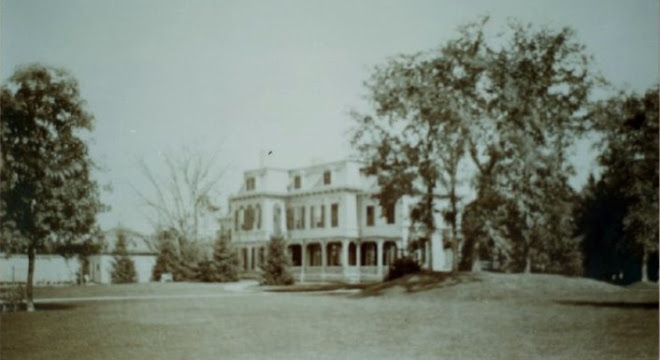Maplehurst: Great estate lies buried in the footprint of the Tappan Zee Bridge
 |
This is the Maplehurst mansion of printing press magnate Robert Hoe II, ca. 1890, looking northwest towards the Hudson River. (Westchester County Historical Society) |
The estate, which abutted west-east Van Wart Avenue to its south from the river to South Broadway, included another large house for Hoe II’s son Robert III.
Robert Hoe, was an English immigrant who founded what became R. Hoe & Company in New York where Robert II was born in 1814. R. Hoe & Co. was the first company in the U.S. to make saws of cast steel and drive the machinery in its factories with steam. The company began making printing presses in 1805 at a time when print was the only widespread form of communication, the high-tech process of its day.
Robert Sr. handed the company to his three sons, including Robert II, in 1841. Robert II’s brother, Richard March Hoe, invented the rotary printing press that revolutionized the newspaper printing process, but Robert II was the company’s business expert. Robert II was also a founder of the National Academy of Design. He died at Maplehurst in 1884.
 |
Granite piers and wrought-iron fencing and gates along South Broadway flank the unpaved 1890 entry to Robert Hoe II’s Maplehurst. (Westchester County Historical Society) |
Legg became president in 1899 of the new Millinery Merchants Protective Association. His lobbying efforts failed and Legg’s allies caved, agreeing to a 1904 deal with the government to ban feathers on hats and protect birds.
 |
The extensive landscaping of Robert Hoe II's Maplehurst estate included a reflecting pond, pictured at lower right in this 1890 photo. (Westchester County Historical Society) |
Brother John Guthrie Luke owned a 42-acre estate at 100 North Broadway in Irvington, not far from Sunnyside Lane. In 1924 it became the site of Irvington House for Cardiac Children and since 1963 has been the site of the non-profit Abbott House, a charity that benefits foster children and adults with developmental disabilities.
Charlton Hall estate in Irvington, which he renamed Devon Hall. It stood where Dows Lane Elementary School and the Half Moon Co-op Apartments now stand, and David Luke and his brother Thomas bought Tarrytown estates. Thomas lived at Braemar, a 17.5-acre estate at the northeast intersection of Broadway and White Plains Road in Tarrytown. Thomas' 1905-build Colonial Revival brick mansion is the only one of those owned by the four brothers that remains today, albeit as an office building and only on 4.5 acres of the former estate that lay east of the Old Croton Aqueduct, at 99 White Plains Road, Tarrytown.
The brothers were all pulp and paper manufacturing company executives of the West Virginia Pulp and Paper Co., founded by their father, Scottish immigrant William Luke.
After several mergers and acquisitions, the company is now known as WestRock, a corrugated packaging company. It was formed in July 2015 after merger with MeadWestvaco (the successor company to West Virginia Pulp and Paper) and RockTen. WestRock was then acknowledged as the second largest American packaging company and one of the world's largest paper and packaging companies with $15 billion in annual revenue and 42,000 employees in 30 countries.
David Luke died of a heart attack at the Savoy Plaza Hotel on April 21, 1934 after attending the Ringling Brothers, Barnum & Bailey Circus at Madison Square Garden with his wife, his son David Jr., and his two grandsons. His funeral services were conducted at his Tarrytown estate, Hawthorne.
Luke left an estate worth $891,000 to his wife and children, showed a probate report filed in December 1936 -- a little over two years after his death. That would be $17.2 million today.
Tragically, in June 1934 David Luke Jr. committed suicide by jumping out of a private plane.
Hawthorne was sold on Jan. 6, 1942, 30 days after the Dec. 7, 1941 attack on Pearl Harbor, for development as the new prospective home of Tarrytown Hospital which stood a mile north of the estate. At the time of the sale, developers planned to renovate the Luke mansion into a hospital and build other new hospital facilities on the 21-acre property which lay between the Hudson River and South Broadway.
The David Lincoln Luke mansion was razed and became the site of a New York State Highway Patrol headquarters off South Broadway next to the entrance of the New York State Thruway onto the old Tappan Zee Bridge until that bridge was torn down in 2015. The site now serves as the gateway to the bicycle and pedestrian path on the northern span of the new $4 billion Tappan Zee Bridge.
AUTHOR’S NOTE: Ever wonder why Tarrytown was chosen as the location for the Tappan Zee Bridge? Believe it or not, atomic-age planners around 1950 felt Tarrytown was far enough away from Manhattan to be outside a nuclear blast zone if New York City were targeted by the Soviet Union during the Cold War. And add to that the fact that it was located about halfway between the two bridges already spanning the Hudson River -- the George Washington and Bear Mountain bridges are 44 miles apart.
















I thought it was located there because NYS didn’t want to give up control to the MTA that controlled all the bridges in NY/NJ metro area.
ReplyDeleteThere was indeed also the thought that the location would prevent New Jersey from entailing any of the toll revenue from the bridge since both sides were in the State of New York.
Delete